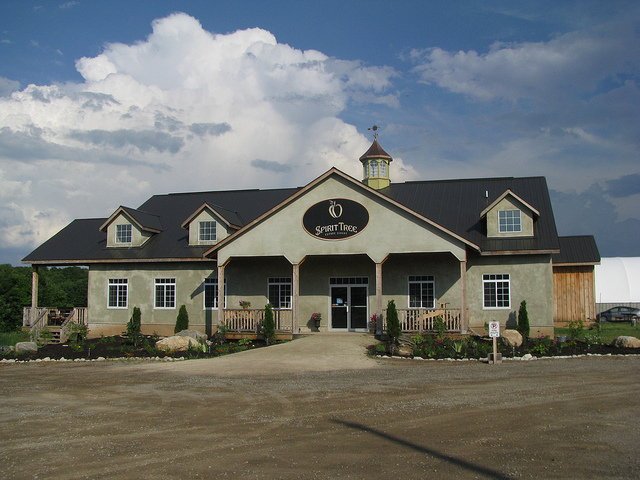After a comprehensive tour of the Millcroft Inn I continued with the historic theme and visited another landmark destination in Alton: the Alton Mill – a former knitting mill that has been converted into an arts centre with 20 studios and more than 30 artists. To learn about the interesting story behind this historically signfiicant building I met with Jeremy Grant, who together with his brother Jordan initiated the astounding transformation of this heritage property.

Starting the tour of the Alton Mill with Jeremy Grant
As we started our walk around the exterior of the building, Jeremy began to explain the fascinating history of the Alton Mill. Originally constructed in 1881 as a woolen mill, the factory produced textiles such as long underwear and mittens. From 1935 onwards the mill underwent a transformation and became a rubber factory that manufactured rubber gloves, balloons and even condoms for World War II servicemen.

The Alton Mill has been an important part of thecomunity for a long time
Business slowed down over the next few decades and finally in the 1980s, the factory closed its doors. Jeremy and Jordan Grant, both active in the urban planning and development field, bought the complex in 1990, but by this time the building had fallen into serious disrepair. The brothers started an extensive process of working with the local municipality as well as the provincial and federal governments to obtain funding for heritage restoration. They engaged renowned heritage architect Catherine Nasmith to protect and showcase the historic features of the complex. The restoration process took almost two decades, but finally, about a year and a half ago, the project was completed and the Alton Mill had been transformed into an outstanding arts centre with state-of-the-art facilities that are also accessible to people with disabilities.

The Alton Mill has been carefully restored
We stopped our stroll on the bridge that connects the Alton Mill with the village, and Jeremy pointed out one of many unique features of this property: the old bridge across Shaw’s Creek had degraded over the years and become no longer repairable. To replace it, Jeremy resorted to an unusual strategy: he used the Internet to look for a bridge for sale. Sure enough, he found one in Northern Ontario and purchased it. The bridge was disassembled at its original site and had to be shipped with police escorts to its new location. The industrial design of the bridge actually fits in very well with the factory complex.

Jeremy points out the bridge that was brought in from Northern Ontario
Then we started walking towards the waterfall where Shaw’s Creek drops down from the Mill Pond. Renowned heritage architect Catherine Nasmith also designed the waterfall viewing platform, which is not only functional, but also makes an artistic statement. A statue of a pregnant woman by Israeli artist Yael Ehrlichman adorned the viewing platform and surely attracts a lot of attention from visitors.

Yael Ehrlichman’s sculpture
The Mill Pond was glistening in the sun in front of us. Next to the building was another statue, this one by artist Bev de Jong, a gate with a stylized woman taking a bath and pointing to the water. The west-facing Pond Gallery is a new addition to the building that adds a magnificent exhibition space.

A gorgeous view over the Mill Pond




